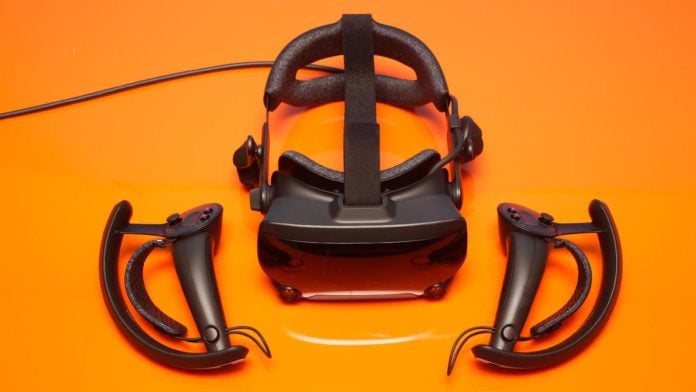In the present time of electronics and gadgets, we can say that two kinds of worlds exist where one is the real world and the other one is the digital or the virtual world. The real world is progressing at a dramatic pace but the virtual world is now growing at a pace beyond our own imagination.
Thus, one might wonder that where does the virtual reality world would go next? With new gadgets being invented for enjoying virtual reality games and videos, there is no looking back. Right now there are primarily two paths of the virtual reality devices. One is the portable and self-contained headsets such as the Oculus Quest or the ones that are connected to the computers and the others are the consoles such as the Rift and PlayStation VR.
The Valve Index (VR Headset) is betting on the second route with the Index, its own VR hardware. It fits in just about all the features that one might expect from a high-end device, including some of the truly transformative finger-sensing controllers.
The Valve Index is said to be a virtual reality headset that is designed and manufactured by Valve. It was announced on April 30, 2019, and the headset was released on June 28, 2019. Some of the important details of the device are a 1440×1600 LCD panel used for each eye giving a total resolution of 2880×1600 for the picture. It is a Second generation device having connectivity employing a DisplayPort 1.2 and a USB 3.0 expansion port.
The entire Valve Index (VR Headset) package cost is $999, 99. This makes it out of reach for several people. But maybe that is the point that it is a boundary-pushing headset that is meant to avoid the VR industry from becoming stale.
Technical specifications of the Valve Index (VR Headset)
The Valve Index (VR Headset) display boasts of having a 1440×1600 per-eye resolution as well as a refresh rate of 120 Hz. This together provides the best visual experience that anyone can find in a VR to date. The ‘screen-door’ effect which had plagued the first-generation VR devices is practically non-existent. There are even dial and a slider for the lens adjustment. This helps one to get the placement almost right for maximum comfort and FOV.
The Valve Index (VR Headset) is a great way to enjoy the virtual world. But to get the complete and uninterrupted experience, certain system requirements need to be known by the users before starting to use the Valve Index (VR Headset). They are mentioned as under –
- RAM required: 8 GB+
- OS required: Windows 10, SteamOS, Linux
- GPU required: AMD RX480+ or NVIDIA GeForce GTX 970+
- Available DisplayPort required: Yes
- HDMI not supported
- CPU required: Dual Core with hyperthreading or advanced
- USB for headset cameras required: 3.0+
- Resolution configuration: 1440×1600 (per eye)
- FOV: ~130 degrees
- Display refresh rate details: 120 Hz (with an experimental 144 Hz mode)
- Audio details: 37.5mm off-ear speakers, along with a built-in microphone
- Tracking details: equipped with the SteamVR 2.0 sensors (they are compatible with the SteamVR 1.0 base stations also).
Read More: All You Need To Know About The New Motorola Razr Fold
Let us have a look at some of the highlighting features of the configuration of the Valve Index (VR Headset), which makes it a class apart in detail:
- The Valve Index (VR Headset) will be a tethered experience having a 5-meter cable which plugs in a beefy gaming PC, and also the one which uses the organization’s laser-firing Lighthouse base stations intending to figure out where the device is at any given time. This is how it allows one to walk around a room’s space worth in a VR — up to a large 10 x 10-meter room. The Valve Index (VR Headset) is not using cameras for an inside-out tracking; the organization says that the twin stereo RGB cameras have been designed to pass through (letting one see the real world via the headset) and for the computer vision community can even dream about.
- The focus of the Index is on delivering the best fidelity VR experience that is possible, meaning it has improved screens, lenses, and audio — which in our case includes a pair of RGB LCs of 1440 x 1600-resolution. The company says that its screens run relatively faster at 120Hz, having an experimental mode of 144Hz — and they are better at combating the “screen door effect” as well as blurry-when-one-moves-the -head persistence issues that the first-gen VR headsets used to struggle with.
- The Valve Index (VR Headset) even has an IPD slider that helps to adjust the distance between the eyes, and the lenses. This offers a 20-degree bigger field of view in comparison to the HTC Vive “for the typical users.”
- The Valve Index (VR Headset) Knuckles controllers are making use of almost 87 sensors, each so that any complexities of the hand movement can be easily translated into the virtual world. The Valve Index (VR Headset) is an impressive piece of user interface design that feels akin to nothing less than magic.
- The Valve Index (VR Headset) standard frame rate is 120 Hz. The Index even offers an experimental 144 Hz mode.
- The Valve Index (VR Headset) makes use of the Base Stations 2.0 for field tracking. The company says that they are “longer-range” and with a better field of vision in comparison to the original one.

Benefits for consumers
The Valve Index (VR Headset) is a state of the art device which is a dream for almost every VR device user. Some of the striking benefits that one gets by making use of the Valve Index (VR Headset) are as follows:
- The Valve Index (VR Headset) provides Excellent image quality. Its enhanced screen provides a better user interface and an amazing VR experience.
- With the exceptional quality of sound and picture, the Valve Index (VR Headset) provides a Realistic presence feel to the users.
- The Valve Index (VR Headset) is an extremely lightweight weight, as well as an Incredibly comfortable headset. The heaviness which one feels on the head while wearing a VR device is almost negligible in the case of this device.
- The Finger-tracking controllers feature adds a new level of immersion to the total VR experience that one can enjoy from the device.
- It has an extremely stable motion as well as a space tracking system.
- Talking about comfort, the Valve Index (VR Headset) even feels great to wear. It is a little heavier than the Rift S—enough though the weight is noticeable in a side-to-side comparison—the design of the head strap better distributes the weight around the head. The strap material feels to be of good quality too. It is more of a padded extra-soft t-shirt than the standard foam padding. It never bothers the user during an extended play session.
- Most importantly, the Valve Index (VR Headset) is comfortable due to how it delivers the audio. The Index has two built-in near-field speakers which hover just near to the ears, and not actually on them. They are powered by the speaker drivers rather than the ones that are usually found in the headphones. What this indicates is that the Index’s speakers provide excellent three-dimensional surround sound without even shutting oneself off to the external noises. With zero pressure on the ears, there is less fatigue for the individual by staying in the VR even for an extended time period.
- One more hallmark feature of the Valve Index (VR Headset) is the new controllers, that double up as both, the typical motion controllers and the hand/finger trackers. The device’s controllers strap up to the player’s hands—meaning one can release the grip entirely even without worrying about the problem of dropping the device. Where the previous touch controllers would only articulate the grip of the user, the Index controllers allow the user to give a thumbs-up, point the finger guns, and even give a Vulcan salute.

Drawbacks
The Valve Index (VR Headset) is a great deal of a VR experience product. But, like any gadget, it also has its own set of drawbacks. Some of the most evident ones are mentioned below:
- The Valve Index (VR Headset) is priced too high as against the pros that it offers. Other devices in the market are priced comparatively lower with almost similar specifications. But for the users who want to have an out of the world experience and are ready to pay the price, this device is suitable.
- There is some Inconvenient wired connection in the device which make it a little clumsy.
- External sensors are sometimes a pain to set up.
- The Finger tracking system is one of the distinguishing features of the Valve Index (VR Headset), but there are not many impressive implementations that have been made yet. The finger tracking feels more like a proof of the concept rather than a groundbreaking gameplay innovation.
Conclusion
Thus to sum it up, it can be seen that the Valve Index (VR Headset) is a great buy for its design and technology. The only drawback of being highly priced puts the device in the niche market which is meant to keep the product being available for true Virtual Reality fans. So if you wish to have an entry into the virtual world, do it with your Valve Index (VR Headset).









